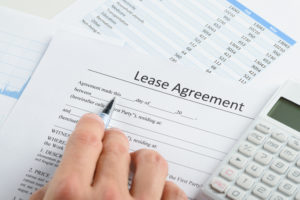Contents
A debt arising from a lease of a vehicle, real estate or other property may be discharged in Chapter 7 or Chapter 13 bankruptcy like any other.
Discharging a contract-related debt in bankruptcy does not require much, in fact.

A debt arising from a lease of a vehicle, real estate or other property may be discharged in Chapter 7 or Chapter 13 bankruptcy like any other. It’s important to note that if a lease is assumed during a Chapter 7 bankruptcy case, it cannot be rescinded or cancelled.
In a Chapter 7 bankruptcy, you simply list the lease on the Statement of Intention section of the bankruptcy petition and check the box for “reject lease.”
In a Chapter 13 bankruptcy, the lease obligation is described in the Chapter 13 plan drafted by your bankruptcy attorney as rejected.
The corresponding personal obligation to perform (i.e., pay money) under the contract may or may not be also included among the credit card, medical, and other unsecured debts on Schedule F of the bankruptcy petition.
That’s it.
Once you receive your discharge, you are free from any obligation to pay the other lease or contract party any money under the terms of the lease or contract.
However, what if you want to continue with a lease?
That is slightly less cut-and-dry.
The Lease Assumption Agreement: Whatever the Creditor Wants It to Be
A lease in bankruptcy must be assumed or rejected by the debtor.
If it is “assumed,” that means that the debtor remains liable for his or her or its obligations under the terms of the contract. It survives the bankruptcy, in other words.
If a lease is “rejected,” it does not.
The Trustee assigned to the bankruptcy case always has 60 days to first assume or reject a contract before the debtor may do so.
With regard to typical vehicle leases or residential leases for apartments or rental homes, etc., this rarely occurs.
Thus, during that 60 day period of time during which the Trustee is (in theory) considering the assumption or rejection of the lease, the debtor filing the case may also negotiate with the lessor-creditor to do so.
Section 365(p) of the U.S. Bankruptcy Code provides that, if a debtor notifies a creditor in writing of an interest in assuming the lease within 30 days of the filing of the case, the creditor may agree to allow the assumption.
In a Chapter 7, this notification generally occurs via the box-checking on the Statement of Intent described above.
If the creditor does agree to the lease assumption, it will, in a Chapter 7, provide a “lease assumption agreement” to the debtor. (In a Chapter 13, the lease is assumed or rejected in the Chapter 13 plan.)
The lease assumption agreement will be a separate contract drafted and provided by the creditor lessor to the debtor for signature.
Section 365(p) of the Code requires nothing in terms of form, presentation, or content from the creditor in this regard.
The Code does not require that the lease assumption agreement be filed with the court or that it is subject to any judicial oversight whatsoever.
Crucially, 365(p) provides no mechanism for rescission (or clawing back) a lease assumption agreement once it is executed.
Once you sign it, you’re stuck with it.
Contrast this with the requirements of a vehicle reaffirmation agreement.
Lease Assumption vs. Debt Reaffirmation
A reaffirmation agreement is also a written agreement sometimes executed during a Chapter 7 bankruptcy case.
Like a lease assumption agreement, it allows a debtor and creditor to agree that a debt obligation survives the bankruptcy discharge.
In the case of a reaffirmation agreement, the debt in question is a secured debt such as a car loan or mortgage.
Unlike a lease assumption agreement, a reaffirmation agreement requires:
- That the debtor have received certain informational disclosures explaining the effect of reaffirmation prior to signing;
- That the agreement be filed with the court;
- That it be accompanied by an affidavit of the debtor’s attorney stating that it is voluntary on the part of the debtor, that it does not impose an undue hardship on the debtor, and that the debtor has been fully advised of the legal consequences of the reaffirmation.
A reaffirmation agreement may, further, be rescinded or cancelled by the debtor anytime prior to discharge or within 60 days of its filing with the Bankruptcy Court.
In Detroit and other Eastern District of Michigan bankruptcy courts, if a reaffirmation agreement is filed without the debtor’s attorney’s signature and which demonstrates “undue hardship,” the court will automatically schedule a hearing at which the court will ensure that the debtor understands the effect of rendering a debt non-dischargeable.
None of this is true with regard to a lease assumption agreement.
Why?
Simply, it is because those who drafted the U.S. Bankruptcy Code failed to insert similar protections into Section 365(p) as in Section 524(c), the reaffirmation agreement provision.
Why again?
The Bankruptcy Code was drafted in original form in 1978, when auto leases were not as prevalent as they are today. Auto leases were marketed in the early 1990s by auto manufacturers as a means of unloading overstocked inventory during a period of flagging sales.
In 1978, people simply purchased cars.
In any case, as with many under-developed and vague portions of the Bankruptcy Code, courts have had to step in to clarify and fill gaps.
Lease Assumption Agreements and Michigan Bankruptcy Courts
In the case of Williams vs. Ford Motor Credit Company LLC, a debtor filed a motion after her bankruptcy discharge to rescind her lease assumption agreement with Ford Motors on the basis that it did not satisfy the consumer protection requirements for a reaffirmation agreement.
The debtor questioned whether a lease assumption was enforceable after discharge if the debtor did not also reaffirm the underlying personal debt obligation.
The Bankruptcy Court in Detroit held that it was enforceable.
On appeal, the Federal District Court in Detroit agreed.
The lease assumption agreement in this case contained an explicit agreement that the protections under Section 524(a) (the reaffirmation Code section) did not apply. The debtor signed her agreement.
Some Bankruptcy Courts around the country have determined that, without the reaffirmation protections attached, Section 365(p) is inconsistent with providing a debtor a “fresh start” as a result of the bankruptcy process.
However, in this case, the Federal Court in Detroit determined that line of reasoning to be contrary to rules of statutory interpretation.
These judicial “rules of thumb” (which are Supreme Court-mandated) require, for example, that a statute not be read so as to render any portion superfluous.
Requiring the reaffirmation protections to be applied to the lease assumption agreement would, the Court decided, render 365(p) superfluous: why have it at all if so?
Additionally, requiring a reaffirmation agreement, which must be filed with the court, to be attached to a lease assumption agreement which does not would render the process unworkable.
It would add a step to the process that Congress chose not to include, which is outside of a court’s discretion.
Lease Assumption Agreements: The Bottom Line
The bottom line here is that you should be cognizant of the risks of signing a lease assumption agreement when filing for Chapter 7 bankruptcy in particular.
As lease assumption in Chapter 13 occurs within the Chapter 13 Plan filed with the court, it is subject to judicial oversight to some extent.
In a Chapter 7—not at all. A lease assumption may take the form of a single paragraph letter, or it may be an elaborate form developed by the eager beaver law firm representing the automobile lessor.
It is important to remember that, in signing such an agreement, you are hitching your wagon to a debt that will travel on past your bankruptcy discharge and from which you will likely receive no permanent benefit. Once signed and in the hands of the lessor, the agreement is binding and cannot be rescinded or cancelled, whether or not the agreement was filed with the Court during the bankruptcy case. It is not subject to the Discharge Order.
When the lease ends, you still have to give the car back and you will be responsible for any excess miles or wear and tear pursuant to the lease agreement.
These documents should be read carefully and discussed in detail with your Detroit bankruptcy attorney before signing and returning, especially if you have the means of obtaining a different car during or after the bankruptcy process.
Attorney Walter Metzen is a Board Certified Bankruptcy Expert and has represented thousands of Chapter 7 and Chapter 13 bankruptcy clients for over 25 years.
Contact us to schedule your initial consultation if you are considering filing for bankruptcy.




